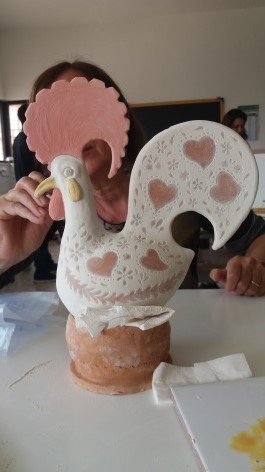Starting training iVET curriculum in GROTTAGLIE
Home › Forums › Objectives › O3 Educational Model – Training Curricula › Training Curricula › Starting training iVET curriculum in GROTTAGLIE
- This topic has 4 replies, 2 voices, and was last updated 6 years, 1 month ago by
Cerasmus+ Team.
-
AuthorPosts
-
October 1, 2019 at 10:46 am #31795
Biagio Zanon
ParticipantWe are working on our training about tradition and innovation.
Here we collect some post from our students.October 1, 2019 at 10:53 am #31796Biagio Zanon
Participant
-
This reply was modified 6 years, 2 months ago by
Biagio Zanon.
-
This reply was modified 6 years, 2 months ago by
Biagio Zanon.
November 26, 2019 at 9:17 am #31809Cerasmus+ Team
KeymasterHello dear readers, ceramists and students,
Here you have the materials produced by the training curricula for Initial VET, on the topic of tradition and innovation, experimented by Istituto Calò (Italy):At this link you can download our Powepoint presentation:
https://www.liceoartisticocalo.edu.it/risorse/cerasmus-training-curricula/I-VET_Tradition-and-Innovation-Grottaglie-Italy_Version-no-videos.ppsxAt this link, the activity report with pictures and videos that our students created about their training “I-VET tradition and innovation”:
https://www.liceoartisticocalo.edu.it/risorse/cerasmus-training-curricula-
This reply was modified 6 years ago by
Cerasmus+ Team.
November 26, 2019 at 9:26 am #31813Cerasmus+ Team
KeymasterPartner: IIS “V. Calò” – Grottaglie, Italy
Dates of implementation: 3th October-14th November 2019
Place of implementation: IIS “V. Calò” – Grottaglie
Topic chosen: Tradition and Innovation
Target group chosen: I-VET
Feedback from teachers: From the results of a satisfaction questionnaire administered
to the teachers at the end of the training, the following data emerged:
the students have established good relationships with colleagues and teachers,
demonstrating the ability to collaborate and work in groups. They performed the
assigned tasks with a fair degree of precision and autonomy. Delivery times have been
respected. The interest and participation were constant and the commitment was
fruitful. Students demonstrated to be aware of the importance of artistic and cultural
heritage for building a territorial identity and the importance of innovating tradition by
looking for creative solutions. They activated work strategies based on critical thinking
and problem solving.Feedback from pupils: From the results of a satisfaction questionnaire given to
students at the end of the training, the following data emerged:
the educational objectives were achieved sufficiently, participation and involvement
were good, the experience was considered satisfactory, consistent with the course of
study, useful for future choices. The training improved the ability to find solutions when
problems occur, stimulated the desire to develop original ideas that could be useful for
the market, motivated them to try to reach their goals with determination, helped to work
as a team and to collaborate with others, helped to understand how to set the objectives
of the activities and to define the priorities. They considered good the level of autonomy
they reached in the execution of the assigned tasks. The teachers were considered to
be clear, helpful and supporting.November 26, 2019 at 11:05 am #31843 -
This reply was modified 6 years, 2 months ago by
-
AuthorPosts
- You must be logged in to reply to this topic.

